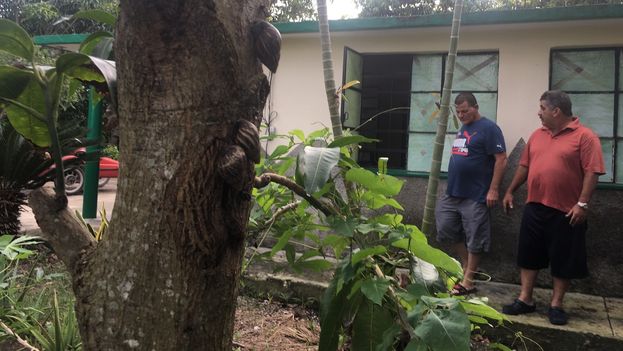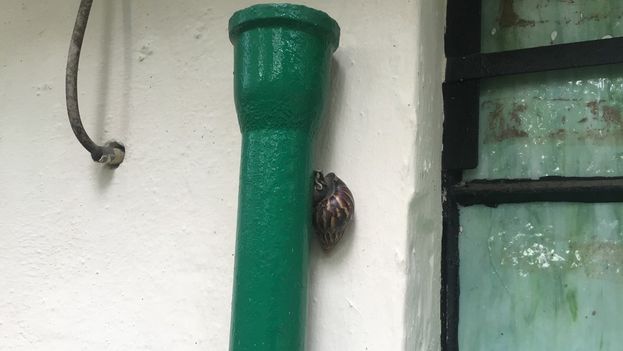
![]() 14ymedio, Reinaldo Escobar, Havana, 14 November 2017 — “Have you come about the Giant African snails?” the residents of the Santa Amalia neighborhood ask any stranger who walks through their streets and seems to be looking for something.
14ymedio, Reinaldo Escobar, Havana, 14 November 2017 — “Have you come about the Giant African snails?” the residents of the Santa Amalia neighborhood ask any stranger who walks through their streets and seems to be looking for something.
People have become increasingly alarmed after the publication, this Sunday, of a reader’s letter sent to the Juventud Rebelde (Rebel Youth) newspaper, warning about the proliferation of the mollusk on the Santa Ana farm in the Arroyo Naranjo municipality. It is the same area where, three years ago, this newspaper uncovered, for the first time, the presence of this dangerous animal in Cuba. Shortly afterwards the official media reported that a citizen of Nigeria had introduced several of these animals to the island, presumably for religious reasons.
Over the months, the plague has been spreading across the area south of the Cuban capital, and has now reached as far as San Antonio de los Baños, Artemisa, according to several contributors to this newspaper.
This Monday, José Antonio Cruz, the author of the Letter to the Editor published in Juventud Rebelde and owner of the Santa Ana farm, spoke with 14ymedio about the alarming situation on his land, located near Grant Street, due to the invasion of the huge snails.
Dozens of these animals, with their narrow conical reddish brown shells with vertical yellow stripes, can be seen on the trees in the courtyard, climbing up the pipes, and moving across the dry leaves of the patio.
The Achatina fulica, the scientific name of the species, is mainly herbivorous, but can also feed on the remains of dead animals, excrement and even some construction materials such as plaster. It can grow to be 8 inches long and it is one of the most harmful invasive exotic species in the world.
Cruz, an engineer with the Public Health services and a member of the Communist Party, tells this newspaper about his odyssey. His “despair, indignation and impotence as a citizen” led him to write the letter and send it “to every place where they may have in their hands the technical and material resources to stop this epidemic.”
Cruz has been living on the farm that belonged to his parents for more than 27 years. “In this place we grow flowers, fruits, root crops and vegetables, and we have to suffer seeing how the snails eat everything, avocados, guavas, mangoes and even the leaves of the malangas,” he tells this newspaper.

However, what worries him most is the imminent danger of an irreversible spread of the plague throughout the country.
“You have to find a solution to this problem, someone has to answer for this,” he protests. The snail, it is known, “has not yet caused any deaths, but it could happen at any time,” he warns.
This species harbors roundworms that transmit diseases such as meningoencephalitis. Children are especially in jeopardy because of their greater tendency to approach the striking animal and to ignore the risks of touching it.
In addition to transmitting parasites and bacteria, the enormous snail causes irreparable damage to the ecosystems it colonizes. It also has a great ability to adapt to varied climates and terrains. In Cuba it does not have natural predators that can curb its devouring cravings.
In the absence of official information speculation springs up, and fear spreads through ignorance. “They say it’s already in the metropolitan park of Havana, in Sancti Spíritus and in San Antonio de los Baños,” says the owner of the farm.
With the exception of Cruz’s letter, the official press has not published any update on the situation of the snail in recent months. As a rule, national newspapers only confirm the presence of a plague or an epidemic after independent media have disseminated the information.
While state guidelines and aid arrive, the inhabitants of Santa Ana farm have not remained idle. All around the house there is an true cemetery of African snails that members of the family have been killing with their own resources.
Rainold Facundo Plascencia, a resident of the area, complains that it is common for farmers to have a wounds on their hands, so they run the risk of getting poisoned if they run their fingers over a place where the snail has left its slime.
Cruz repeats that he has complained to the municipal section of the Party, Public Health, Plant Health, Epidemiology and the Ministry of Agriculture. “When I saw that there was so much apathy, I decided to write to the newspaper,” he explains.
The alternative solution that they have found to liquidate these hermaphroditic mollusks, capable of putting out up to 1,200 eggs in a year, is to sprinkle them with common salt, but it cannot be applied intensively because there is a risk of salinizing the soil.
In addition, salt is a rationed product and there are frequently shortages of it. “Finding a pound of salt is sometimes more difficult than spending a day smacking those snails,” adds a resident of Grant Street.
José Antonio Cruz believes that state institutions should be involved in the problem. “It is not possible for a person, or for a small group of farmers, to eradicate this plague, it would be necessary to fumigate the land or to apply a radical variant that is not in our hands.”
Several of those affected insist that they do not want to “turn this issue into a political problem,” because when these irregularities are pointed out there is always the risk of being misinterpreted.
Cruz shares this concern, but adds that you can’t be afraid to tell the truth. While speaking, he keeps his brow furrowed and his eyes fixed on a snail that is climbing up the trunk of a nearby tree. “A man who does not say what he thinks is not an honest man,” he says, paraphrasing José Martí.
_____________________________
The 14ymedio team is committed to serious journalism that reflects the reality of deep Cuba. Thank you for joining us on this long road. We invite you to continue supporting us, but this time by becoming a member of 14ymedio. Together we can continue to transform journalism in Cuba.
